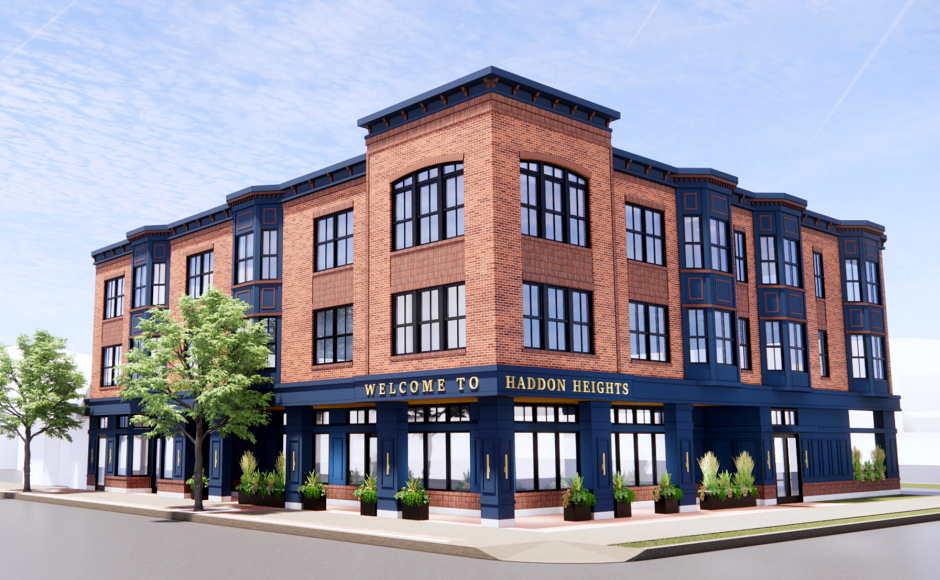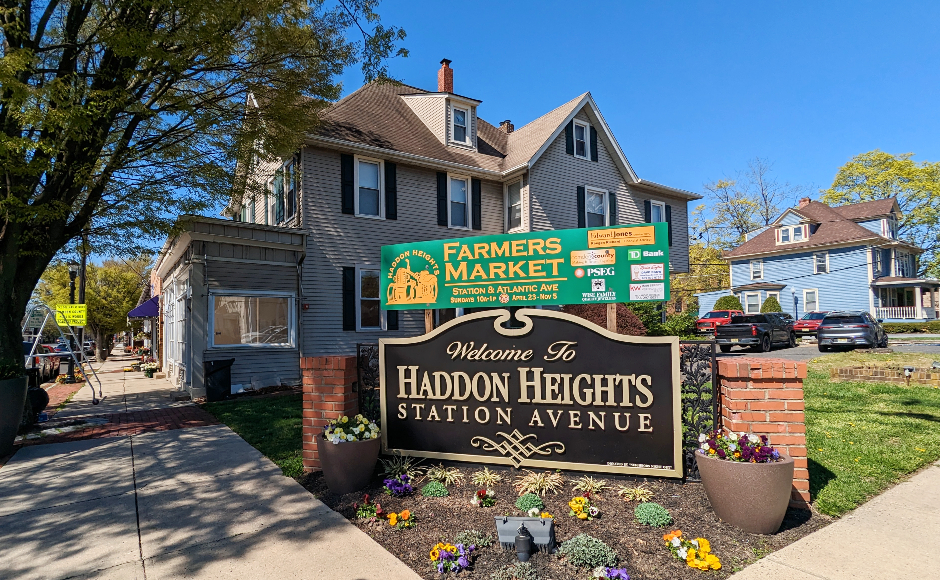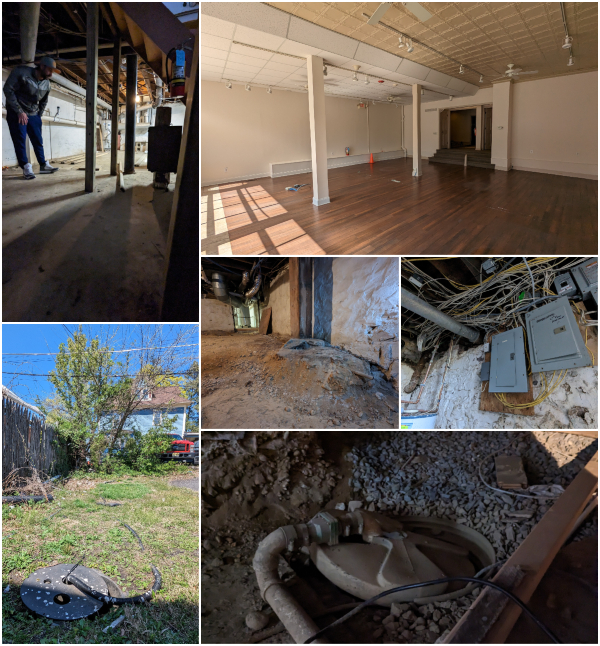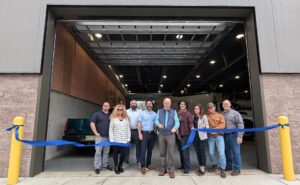A proposal to revive a 121-year-old building in the historic Station Avenue business district has sparked a community conversation about the future of the borough downtown.
By Matt Skoufalos | April 13, 2023
Plans to redevelop a gateway property at the edge of the Haddon Heights business district have kicked off a community conversation about how best to balance historic preservation with opportunities for growth in the next 100 years.
The project spans 501 Station Avenue, a three-story commercial storefront with apartments above, and the neighboring structure at 503, a single-story commercial building that currently houses Freshest Flowers.
Owners Gary Farrell and Anthony Gioielli, who operate as Broken Ground Properties, would like to demolish both, replacing them with a contemporary, mixed-use, commercial/residential property that would add a dozen one- and two-bedroom residential units over two commercial spaces.
Broken Ground made its first public presentation to the Haddon Heights Historic Preservation Commission (HPC) on March 30; after a lengthy discussion, the body voted to delay ruling on the application for 30 days.
In that conversation, the commission heard from borough residents and business owners both in favor of and opposing the project from various perspectives.
Haddon Heights Councilman Christopher Morgan, liaison to the HPC, addressed the challenges of having a vacant commercial space at the entrance to the borough business district.
“That this building has sat unoccupied for so long, and that it has had such a difficult time being sold, is very telling with regard to the viability of that building as an ongoing commercial concern,” Morgan said. “It does not look like it may have once done in its heyday, and I think it’s definitely affecting the neighboring properties.”
HPC Chair Carol Larro worried that tearing down the historic structure could potentially sacrifice a piece of local history, while also setting an unwelcome precedent for other demolition in the historic district.
“Truly, this is the first [proposed] demolition in the historic district,” Larro said, before introducing the motion for a 30-day review.
“It worries me because it seems like it might be the beginning of many more buildings, because I do know that there’s people in town who have purchased some of the buildings along Station Avenue, and they do plan on demolishing them and building something else.
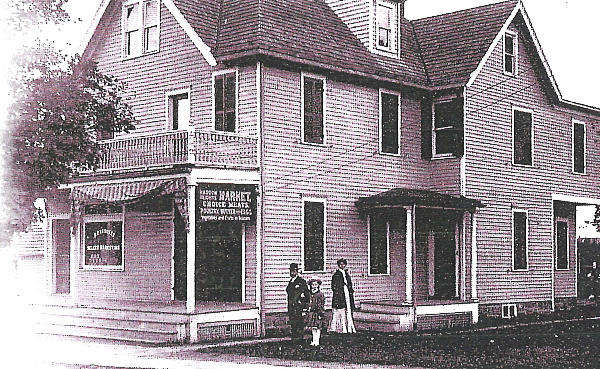
501 Station Avenue, Haddon Heights, circa 1910. Credit: Haddon Heights Library/Historical Society Bulletin.
“We need to continue to improve what we have, but I think because we’re talking about the actual demolition of two buildings in the national register, in the state register, this is an important decision,” she said.
Responding to the rhythm of the street
Historic preservation architect Margaret Westfield, who lives and works in a 118-year-old historic home on the White Horse Pike in Haddon Heights, is as much an expert on the subject of local historic context as anyone in the discussion could be.
Westfield has served on the state historical commission since 2009. She’s nominated dozens of historic properties for the national register, written handbooks and design guidelines for communities with properties of historic significance, and personally researched and designed some 20 markers for historic locations within Haddon Heights.
“Historic preservation is all we do,” Westfield said. “We work with old buildings and new construction in a historic context. This [project] is very near and dear to me because this is right at the entrance to Station Avenue and the White Horse Pike.
“Mayor and council are very in favor of redevelopment; I’m interested in making something that won’t be out of context with our historic district,” she said.
The historic significance of 501 Station Avenue is not in doubt. The property was constructed as an addition to an existing real estate building in 1902, when Benjamin Parker Crookes established a market for local meat and dairy goods.
The Crookes family were prominent within the borough, but even had they not been, their building was written into local history in 1989, when the Station Avenue business district, which includes the property at 501, was listed on the National Register of Historic Places.
The intervening years, however, have not been kind to the building. A May 2022 report from Leake Engineering of Havertown, Pennsylvania, concluded that it is unsafe, owing to a foundation compromised by water infiltration, the installations of “various electrical, mechanical, and plumbing systems,” and failing supportive mechanisms.
“A feasible alternative to the recommendations above,” the report concludes, “would be to demolish the building.”
A walk-through of the property underscores the conditions observed in that engineering assessment.
The rear yard is marked by a small gravel parking lot, along which runs a series of sump pumps, ostensibly to dispel stormwater from the paved parking lot at 126 White Horse Pike (the historic Crookes family home).
The building at 501 Station is not aided in this deterrence by its flat, black roof; like many businesses in the historic district, it consistently contends with flooding.
Despite the presence of a motley network of drainage systems, its basement, which is little more than a dirt floor in many places, shows signs of water infiltration as well as standing water.
Some support beams don’t make contact with the basement floor. Numerous joists sag along its crumbling walls, and a rat’s nest of wiring illustrates the various electrical systems that have been run there over the years.
More problems evident in its commercial and residential units can be traced back to the compromised foundation of the building, but present most plainly as uneven floors, ceilings, and door frames offset by patchwork fixes.
“It’s called demolition by neglect when a property owner doesn’t maintain a building and it falls into disrepair by that,” Westfield said. “I think that’s really what has doomed this building.”
Although Westfield believes that it’s entirely possible to restore 501 Station Avenue in keeping with historic criteria, she is doubtful that’s the approach its new owners would like to take. Her focus has therefore shifted to advocating for the structure replacing it to be tightly integrated within the borough downtown business district.
“I believe it’s already been decided that this building is going to be demolished,” Westfield said. “I think that’s unfortunate, but I’m recognizing that the priority here for new development is to be seen to be revitalizing the district.
“If, in fact, you want to do new construction, do it right, so it fits in,” she said.
Although Farrell and Gioielli’s March 30 HPC presentation was the first to have a public hearing, the two had previously and informally solicited input from the commission on a prior design for the property.
Westfield was critical of the building massing and proportions of both attempts as being inconsistent with the borough statute describing design criteria for improvements within the historic district; at the time of this interview, she had not seen their third revision, which was developed within the past week.

Margaret Westfield at Lucy the Elephant in 2009. Credit: Bill Cramer, Wonderful Machine, Inc., courtesy of Margaret Westfield.
“There’s 12 things in the [historic preservation] ordinance,” Westfield said.
“The whole reason it exists is to help people design buildings that fit into the historic district.
“[A building] can look modern,” she said.
“It doesn’t have to look like an old building, it just needs to be respectful to the historic context, the rhythm of the buildings on the street, the size, and the shape, and the height.”
Since the property at 501 Station Avenue comprises two buildings, Westfield argued that whatever replaces them should be differentiated in its design, the better to continue the architectural rhythm of the street.
“You could have two storefronts in one building that has the appearance of two buildings,” she said. “Maybe it’s linked at the back. You could have the apartments above that.”
Westfield also questions the density of the project, both in terms of its setback from the White Horse Pike (too small) and its overall footprint (too big).
“The reason I think the current building, as designed, doesn’t fit in, is because it was designed around what they were putting inside of it rather than the site,” she said. “They wanted to put in two storefronts, 12 apartments, and designed a building that would accommodate those things without thinking about this particular location.
“It’s got to be a give-and-take; it’s got to be a compromise.”
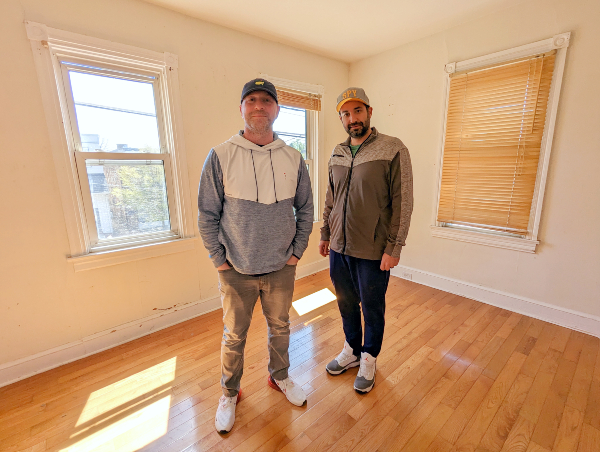
Anthony Gioielli (left) and Gary Farrell of Broken Ground Properties in a residential unit at 501 Station Avenue. Credit: Matt Skoufalos.
‘If we’re going to do this, we’ve got to do this the right way’
Gioielli and Farrell believe their efforts to design a right-sized redevelopment for Haddon Heights have been rooted in compromise from the start.
That’s why, they say, after consultations with Haddon Heights HPC and public feedback from the March 30 meeting, the project is on its second redesign.
The latest version, which is slated for presentation at the next HPC meeting, swaps some of its open-air balconies for enclosed facades approximating some of the window shapes seen in commercial buildings in the 600 block of Station Avenue.
Its White Horse Pike setback has been adjusted somewhat to allow for greater pedestrian visibility. There’s a vacant wall that Gioielli said could be transformed into a mural dedicated to the historic significance of the building; a nod to the local history behind the property.
He attributes the larger proposed building massing in his design as necessary to accommodate an elevator that will make its residential units more accessible to tenants, especially Haddon Heights residents who may want to downsize from a larger neighborhood home in order to age in place.
“We could have done this as a three-story walk-up, but that doesn’t solve problems for older residents,” he said.
Farrell points out that, even with its larger building massing, the proposed overhang design only covers 70 to 80 percent of the lot, which is less than other buildings in the district. A planned green roof would also help absorb rainwater and offset runoff.
Gioielli added that the opportunity of demolishing the existing building at 501 Station also facilitates long-term solutions to water intrusion problems in the block by offering an opportunity to excavate the insufficient fixes currently in place.
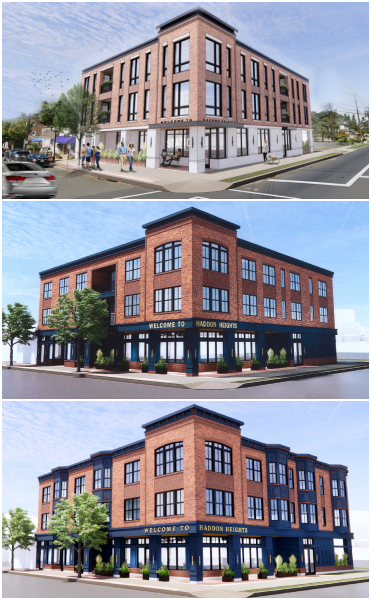
Building elevations for 501 Station Avenue have changed through three iterations. Credit: Gnome Architects/Broken Ground Properties.
“We can’t fix everybody’s water problems, but it’s a good start,” Farrell said.
“Maybe down the line, it’s a bigger solution.”
Gioielli and Farrell come to Haddon Heights with a portfolio of 60 property redevelopment projects, the majority of which are located in Philadelphia and the surrounding areas.
(Of these, Gioielli points out that only two have been teardowns.)
In Haddon Heights, Broken Ground sees the opportunity to put down roots in a South Jersey community that could also serve as the new headquarters for their business.
“When we were looking for places, we wanted something where we could have another office,” Farrell said.
“Originally, we were planning on just renovating the top, and then the redevelopment overlay came about, and at that point, we were like, ‘If we’re going to do this, we’ve got to do this the right way,’” he said.
Beyond failing to keep up the building in general, Gioielli points out that its prior owners also made changes that undermined its historic architecture.
He and Farrell are open to “as much feedback as possible” from HPC on the building design, but don’t believe the building in its current form can stay.
“I do think this building would have to go,” Gioielli said. “Looking at it as a straight renovation just doesn’t make sense.
“I don’t want to see the slippery slope of people coming up and knocking down buildings,” he said. “Sometimes the property does warrant that.”
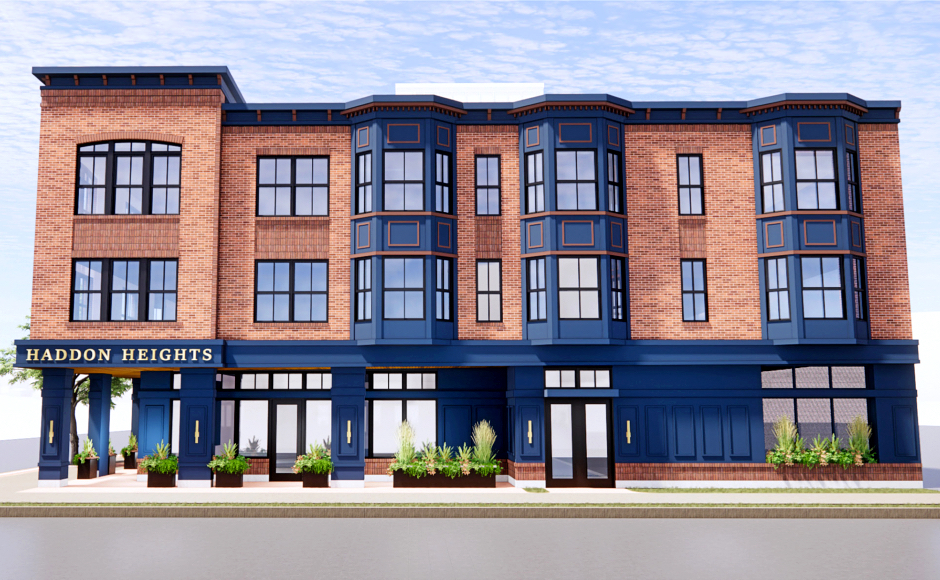
501 Station Ave, White Horse Pike frontage, v3.0. Credit: Gnome Architects/Broken Ground Properties.
‘Let’s make a vibrant downtown’
After two-and-a-half years of work to introduce a redevelopment plan to the borough,
Haddon Heights Mayor Zach Houck said that whatever the outcome of the project, he’s heartened by the energy around the discussion it’s generated. Houck urged residents to follow the process through to its conclusion through the normal channels.
“I am happy that there’s that concern,” the mayor said. “I think that concern exists whenever an argument’s posed. In this case, I ask the public — as I did everyone when we pushed for the redevelopment zoning — have faith in your elected officials.
“The process is public and it’s open,” he said. “There’s nothing secret here. If you look at the process as a whole, these developers have worked with members of the historic preservation commission (HPC) since the very beginning. Their latest design is their third because they’re listening to the public.”
It’s precisely his faith in the multilayered board reviews inherent in the redevelopment process that keeps Houck from worrying about the 501 Station Avenue project becoming a test case for slippery-slope mass demolition of other historic properties in the borough business district. Each property is considered on its individual merits, and follows a prescribed process that involves reviews from the borough council, historic, and land-use boards.
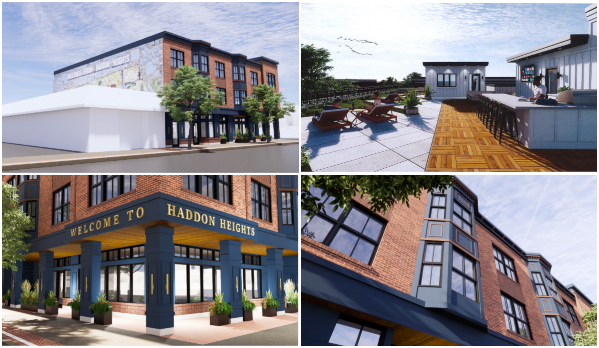
501 Station Avenue renderings. Clockwise, from top left: a potential mural wall, rooftop deck with rain garden, building elevations as seen from sidewalk perspective. Credit: Gnome Architecture/Broken Ground Properties.
Moreover, the mayor believes that redevelopment in general can facilitate the next phase of evolution for the community — whether it be adding residential density to support its commercial districts or help senior residents age in place, improving dilapidated properties to attract new business, or mitigating environmental issues, like the stormwater runoff in the business district.
“We believe in Haddon Heights,” Houck said. “We just want to see it a little bit more lively; a little bit more fruitful in our downtown. Redevelopment does open up opportunities for us to try to mitigate bigger issues.”
Whatever the outcome of the project, Houck said the conversation reflects a healthy interest in Haddon Heights that indicates its viability as a community for economic investment, of which he is bullish on redevelopment as a key lever.
“You’re going to see more and more towns on the pike using redevelopment to attract developers,” the mayor said. “The vision really is, ‘Let’s strengthen our downtown. Let’s make it a vibrant downtown.’”

